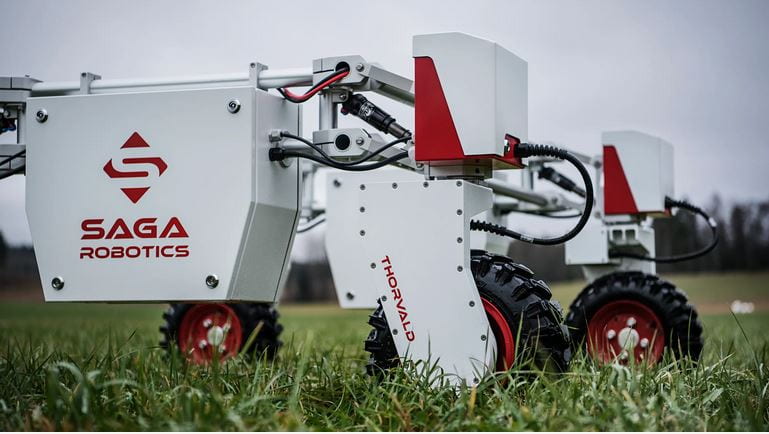
Credit: Farm Wise 
Credit: SkyGrow 
Credit: Saga Robotics
There are several sub-classifications of mobile robots that operate on the ground, such as wheeled mobile robots, legged robots, tracked (treaded) robots, or hybrids of the three (Rubio et al., 2019). In the field of Environmental Robotics, most ground research has focused on either wheeled mobile robots (WMR) or tracked robots, as when moving across fields and open terrain that is not guaranteed to be flat, wheels and treads have advantages over legs; they are simpler and tend to not have difficulty balancing, as most of the robot is usually in contact with the surface it is traversing (Rubio et al., 2019).
Ground Robots can make agriculture more environmentally friendly. They can be used to detect chemical levels in the soil. By analyzing the data, the optimum levels of fertilizers, whether chemical or natural, can be determined for maximum productivity. Robots can also be used to automate tasks such as planting, sowing, and watering. All these tasks can be carried out with precision and in a short time with the help of robots. Robots can also be used for crop harvesting, as robots attached with sensors and computer vision can determine the optimum time for picking up fruits and vegetables. Robots can also be used for livestock farming, for instance, where they can be used for milking cows or managing a herd of domesticated animals.
- To address the growing disruption of the nitrogen cycle, a 2017 paper published in the Computers and Electronics in Agriculture journal detailed a study wherein a tracked robotic system developed to manage nitrogen fertilization in greenhouse crops was able to decrease nitrogen fertilizer consumption by about 18% [1]. The robot was designed to operate in hydroponic commercial greenhouses—or closed, indoor systems in which the temperature, lighting, and soil pH and nutrients are controlled variables to increase plant production—where it moved on a platform between the rows of crops. The study used an algorithm with a feedback loop to control the trajectory of the robot in the greenhouse based on the projected path uploaded by the robot and the current position of the robot from a GPS (Global Positioning System) module. The robot used Machine vision and Image processing to find the optimum time of nitrogen fertilization for the plants: it took pictures of the plants, filtered out the sunlight on the leaves to create a baseline lighting level, and then calculated image textural features like entropy, energy, and local homogeneity.
- Another study, published in the Biosystems Engineering Journal in 2016, aimed to reduce atmospheric air pollution with hybrid-powered robotic tractors [2]. The hybrid system, which consisted of the tractors’ original combustion engine in combination with a new electrical energy system and hydrogen fuel cell, proved to reduce exhaust emissions by almost 50% in the best case. The upgraded tractor was designed with the intention that it would still be able to accomplish three agricultural tasks: weed control with a flaming and a row crop cultivator implement, weed control with an herbicide patch sprayer, and pest control with a canopy sprayer. These agricultural implements required power for hydraulic pumps and fans, which were provided by electric power, as part of the new hybrid system.
- Focusing on sustainable agricultural practices with ground robotics, FarmWise—a startup company founded in 2016 in Salinas Valley, California, and Yuma, Arizona—aims to increase food production efficiency and streamline farm operations through the deployment of autonomous weeding machines. These robots use Computer vision to identify a variety of crops such as leafy greens, cauliflower, and broccoli and then use custom arms to pick out unrecognized plants, or weeds.
- Tortuga AgTech—a startup, founded in Denver, Colorado—is focusing its efforts on the sustainable and automated planting and harvesting of the crops themselves through robotics and AI to help farmers prepare for the growing climate change crisis.
- SagaRobotics, a Norwegian startup founded in 2016, was created with the aim to introduce robots into agriculture to make farming more sustainable. The company has created Thorvald, a modular, autonomous robot that can perform UV treatment, pick fruits and vegetables, spray pesticides, and collect data to predict crop growth and yields. So far, the robot can operate in strawberry fields and grapevines.
- SkyGrow, located in Queensland, Australia, intends to combat climate change by planting trees—specifically, 220 million trees by 2030. As existing technologies for planting trees are either time-consuming and safe or fast and unsafe, SkyGrow has developed swarms of “Growbots” that can autonomously plant trees using Global Positioning Systems (GPS) and are powered by renewable energy. Growbots can plant up to 4 times faster, are safer, are less expensive than traditional techniques, and lower labor efforts by at least 40%.
- Besides reimagining agriculture (planting or weeding) through robotics technology, Ground Mobile Robots have found their application in the prevention of Biodiversity loss. Originally designed by Justin Werfel, Ph.D., and Nathan Melenbrink at the Wyss Institute’s Bioinspired Robotics Platform to install foundations for bridges and other large structures, the creators later realized that their system, Romu, could also be applied to environmental restoration. The lightweight, autonomous sheet-pile-driving robot can work in swarms to stabilize vulnerable habitats by forming check dams, which prevent erosion, reduce flash-flooding, and promote groundwater recharge.
- Environmental robotics can even be applied to industries not primarily associated with environmental action; diesel yard trucks—trucks designed to move trailers and containers around facilities—emit an estimated 3.8 million tons of carbon dioxide every year. Reducing or even eliminating those emissions through robotics technology could greatly affect atmospheric pollution. Therefore, Outrider, a startup company founded in Golden, Colorado, has developed autonomous, electric-powered, zero-emission yard trucks: to drive the rapid adoption of sustainable freight transportation.
| Marine Robotics | Aerial Robotics | Industrial Robotics |
References:
[1] A farmer-assistant robot for nitrogen fertilizing management of greenhouse crops, Vakilian et al.(2017)
[2] Reducing air pollution with hybrid-powered robotic tractors for precision agriculture, Gonzalez-de-soto et al.(2016).